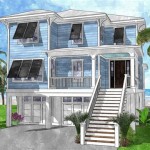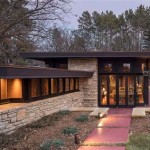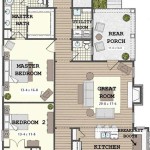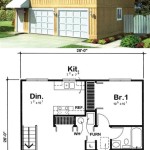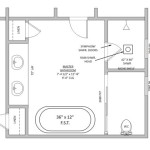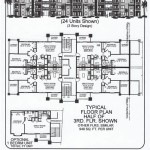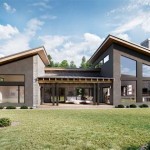Building Plan for 1000 Sq Ft: A Comprehensive Guide
Designing a building plan for a 1000 square foot (sq ft) home requires careful consideration of space utilization, functionality, and compliance with local building codes. This article provides a detailed overview of the critical aspects involved in creating such a plan, covering various layouts, essential components, and important considerations to ensure a comfortable and efficient living space.
The efficient use of available space is paramount when designing a smaller home. Every square foot must be thoughtfully allocated to maximize comfort and usability. This involves minimizing wasted space, integrating multi-functional design elements, and prioritizing the needs and lifestyle of the occupants.
A crucial initial step involves a thorough assessment of the property. This includes understanding the site's dimensions, topography, soil conditions, and any existing easements or restrictions. These factors will directly influence the type of foundation suitable for the building, the drainage requirements, and the overall orientation of the structure.
Local building codes and regulations are non-negotiable aspects of any building plan. These codes dictate minimum room sizes, setback requirements, fire safety standards, and accessibility provisions. Failure to adhere to these regulations can result in costly revisions or even the rejection of the building permit application. Therefore, consulting with local authorities and engaging a qualified architect or engineer is crucial to ensure compliance throughout the design and construction process.
Key Considerations for Layout and Design
The layout of a 1000 sq ft home requires thoughtful planning to accommodate essential living spaces and maximize functionality. Several popular layout options can be adapted to suit individual needs and preferences. These include open-concept designs, compartmentalized layouts, and combinations of both.
Open-concept layouts are particularly well-suited for smaller homes as they create a sense of spaciousness by combining the living room, dining area, and kitchen into a single, flowing space. This design encourages natural light penetration and promotes social interaction. However, it may require careful consideration of noise control and privacy.
Compartmentalized layouts, on the other hand, offer more defined spaces and increased privacy. This option typically involves separate rooms for the living room, kitchen, bedrooms, and bathrooms. While this layout can feel more contained, it can also provide a greater sense of order and organization.
Hybrid layouts combine elements of both open-concept and compartmentalized designs. For example, the living room and dining area may be combined in an open space, while the bedrooms and bathrooms are separated for privacy. This approach allows for a balance between spaciousness and functionality.
When designing the layout, it's important to consider the flow of traffic within the home. Pathways should be clear and unobstructed, allowing for easy movement between different areas. Minimizing hallways and incorporating storage solutions into the design can further optimize space utilization.
The orientation of the home on the property can significantly impact energy efficiency and comfort. Orienting the main living areas towards the south can maximize solar gain during the winter months, reducing heating costs. Similarly, providing shade on the west-facing windows can minimize heat gain during the summer, reducing cooling costs. Strategic landscaping can also contribute to energy efficiency by providing shade and windbreaks.
Essential Components of a 1000 Sq Ft Building Plan
A comprehensive building plan includes detailed information about all aspects of the construction process. This includes architectural drawings, structural engineering plans, electrical diagrams, plumbing layouts, and HVAC (heating, ventilation, and air conditioning) schematics. Each component plays a crucial role in ensuring the safety, functionality, and longevity of the home.
Architectural drawings typically include floor plans, elevations, sections, and site plans. Floor plans show the layout of each room, including dimensions, door and window locations, and the placement of fixtures and appliances. Elevations depict the exterior appearance of the home from different angles. Sections provide a cutaway view of the building, revealing the internal structure and materials. Site plans show the location of the building on the property, including setbacks, landscaping, and utilities.
Structural engineering plans specify the materials and methods used to construct the load-bearing elements of the home, such as the foundation, walls, and roof. These plans are essential for ensuring the structural integrity and safety of the building. They include details about the size and spacing of beams, columns, and joists, as well as the type and grade of concrete, steel, and lumber used in construction. Soil testing and analysis are critical components of the structural engineering process, as they provide information about the soil's bearing capacity and stability.
Electrical diagrams illustrate the wiring layout of the home, including the location of outlets, switches, light fixtures, and electrical panels. These diagrams must comply with local electrical codes and ensure the safe and efficient distribution of electricity throughout the building. A load calculation is typically performed to determine the appropriate size of the electrical service and the capacity of the circuit breakers. Proper grounding and surge protection are also essential for safety.
Plumbing layouts depict the location of water supply lines, drain lines, and plumbing fixtures, such as sinks, toilets, showers, and bathtubs. These layouts must comply with local plumbing codes and ensure the proper functioning of the plumbing system. Proper venting is essential to prevent sewer gases from entering the home and to ensure the efficient drainage of wastewater. Water conservation measures, such as low-flow fixtures and rainwater harvesting systems, can also be incorporated into the plumbing design.
HVAC schematics illustrate the layout of the heating, ventilation, and air conditioning system, including the location of the furnace, air conditioner, ductwork, and registers. These schematics must be designed to provide adequate heating and cooling throughout the home while minimizing energy consumption. Energy-efficient HVAC systems, such as heat pumps and high-efficiency furnaces, can significantly reduce energy costs. Proper insulation and air sealing are also crucial for minimizing heat loss and gain.
Maximizing Space and Functionality in a 1000 Sq Ft Home
Effective space utilization is crucial in a 1000 sq ft home. Employing creative storage solutions, multi-functional furniture, and space-saving appliances can significantly enhance the living experience. Vertical storage, such as built-in shelves and cabinets that extend to the ceiling, can maximize storage capacity without occupying valuable floor space. Loft beds and Murphy beds can free up floor space during the day, allowing a single room to serve multiple purposes.
Multi-functional furniture is designed to serve more than one purpose. Examples include sofa beds, storage ottomans, and dining tables that can be extended or folded away when not in use. These pieces can significantly reduce clutter and maximize the flexibility of the living space.
Space-saving appliances, such as compact refrigerators, stackable washer and dryers, and built-in ovens, can also help to optimize space utilization. These appliances are designed to fit into smaller spaces without sacrificing functionality. Integrating appliances seamlessly into the kitchen design can further enhance the overall aesthetic and efficiency of the space.
Natural light can significantly enhance the feeling of spaciousness in a small home. Incorporating large windows and skylights can maximize natural light penetration, making the interior feel brighter and more open. Light-colored walls and flooring can also help to reflect light and create a sense of airiness.
Using mirrors strategically can create the illusion of more space. Placing a large mirror on a wall can visually double the size of a room. Mirrors can also be used to reflect natural light, further enhancing the brightness and openness of the space.
Finally, a well-organized and clutter-free home will always feel more spacious and comfortable. Regularly decluttering and organizing the living space can significantly improve the overall quality of life in a 1000 sq ft home.

Our Top 1 000 Sq Ft House Plans Houseplans Blog Com

Three Low Budget 1000 Sq Ft Bedroom House Plans For 120 Yard 3 Cent Plots Small Hub

𝟏𝟎𝟎𝟎 𝐒𝐪 𝐅𝐭 𝐇𝐨𝐮𝐬𝐞 𝐃𝐞𝐬𝐢𝐠𝐧𝐬 With Images

1000 Sq Ft House Plan N Design August 2024 Floor Plans

House Plans Under 1000 Square Feet

1000 Sqft House Plan Customized Designs By Professionals Imagination Shaper

Traditional Plan 1 000 Square Feet 2 Bedrooms Bathrooms 348 00002

2bhk Floor Plan 1000 Sqft House South Facing Houseplansdaily

House Plan Choosing Between 1000 Sqft And 2000 Options Green Arch World

1000 Sq Ft House Plans 3 Bedroom N Style 25x40 Plan Design

